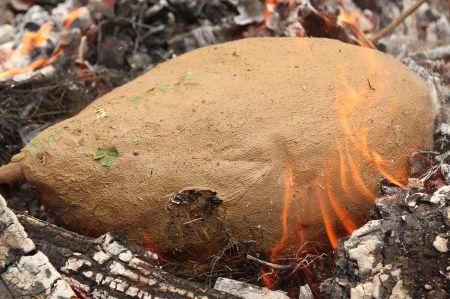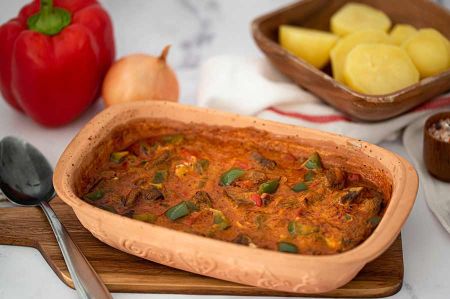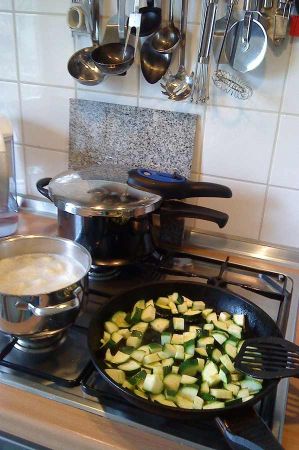The forerunners of the Roman pot and steam cooking
- Written by Portal Editor
Our friend Silverio invited us to dinner over the weekend because he wanted to show us his city and especially his cooking skills. For years he has been dealing with local cooking customs, some of which can be traced back to the ancient Romans in their recipes, and even partly reflect their recipes and eating habits.
The weekend promised to be interesting, as culinary traditions allow many conclusions to be drawn about life back then. We would also like to add a cross-reference to Dr. Robert Krickl from Brunn am Gebirge / Vienna, who used practical examples in cooking classes to demonstrate the connection between ancient Roman cooking and modern dishes during his unique Roman festival.
Of course, we were excited to see what our master chef would serve us in the evening.
We were a little surprised because we found a freshly dug pit measuring approx. 1.20 x 0.70 meters in the garden, with a large pile of dry firewood right next to it.
The first forebodings arose when our host explained that there would be a braised piglet. We found the "roast" fully prepared, i.e. gutted and filled with various herbs and vegetables, in the kitchen.
The kitchen table was covered with plastic film and the floor was largely covered with old newspapers.
What follows now? The answer came spontaneously and absolutely surprisingly: Now let's build the pot for the braise!
What we initially thought was fun was soon put into practice, as a large container of clay-like soil was placed on the side table.
Silverio immediately reached into the slippery mass with both hands, took out the first lump, which was placed in a flat shape on the well-oiled roast.
We followed his instructions, formed more clay cakes and used them to completely cover the “roast”.
At first it was a little difficult because of the oil, but after a short time I was able to wrap the entire roast with the loamy clay mixture and close the joints. Which we have been pointed out several times. Was this the forerunner of the Roman pot?
 Now we went out into the garden to the pit I had already mentioned, in which a layer of clay bricks had been placed. Our pot roast, wrapped in clay, was placed on the bricks, surrounded with clay bricks, covered and the remaining pit was covered with gravel and sand.
Now we went out into the garden to the pit I had already mentioned, in which a layer of clay bricks had been placed. Our pot roast, wrapped in clay, was placed on the bricks, surrounded with clay bricks, covered and the remaining pit was covered with gravel and sand.
Now the firewood was piled up on the now closed pit and ignited. A strong campfire was quickly lit and some drinks were served, because now it was time to wait and see.
The only important thing is that the fire must not go out. The principle slowly became clear to us because we had already heard of so-called earth ovens from other cultures. We were excited to see the results of this type of cooking.
 Probably every modern person is familiar with the so-called Roman pots made of clay, which, like a fashion, are increasingly appearing in today's kitchens for preparing food in the oven. Hunters are known from ancient cultures to wrap their prey in a clay coat and then cook it over an open fire or in the ashes. The healthy invention “steam cooking” in its raw version. We know from Roman culinary culture that the Romans always preferred cooking in clay pots to cooking in iron pots; they are considered the perfectionists of steam cooking, which basically means nothing more than cooking in their own juice. This type of cooking has evolved in many cultures:
Probably every modern person is familiar with the so-called Roman pots made of clay, which, like a fashion, are increasingly appearing in today's kitchens for preparing food in the oven. Hunters are known from ancient cultures to wrap their prey in a clay coat and then cook it over an open fire or in the ashes. The healthy invention “steam cooking” in its raw version. We know from Roman culinary culture that the Romans always preferred cooking in clay pots to cooking in iron pots; they are considered the perfectionists of steam cooking, which basically means nothing more than cooking in their own juice. This type of cooking has evolved in many cultures:
- in the Balkans, the Duveč dish in the pot of the same name
- in Turkey the lamb dish Kuzu Güveç
- in Italy the open version pirofila di terracotta
In Cappadocia, to be precise in the town of Ürgüp, while visiting a weekly market, we came across vegetable stews that, although smaller in form, demonstrated steam cooking in their own juice in an almost perfect way. The vegetable and meat mixture of your choice was placed in small clay pots and closed with a lid. To ensure that no liquid escapes during the cooking process, the lid was “sealed” with bread dough. During the cooking process, a circular bread was baked at the same time. See image gallery. A little observation sometimes reveals surprising variants of actually known procedures. The same applies to almost all methods of cooking in your own juice, especially when using clay pots:
- Cooking takes place with minimal or no addition of liquid. So they remain the taste, juice, aroma and nutrients are almost completely preserved.
- Almost all dishes can be cooked without adding fat.
- The lid protects the oven from contamination caused by splashes, nothing can burn or overcook.
- If the food stays in the oven for too long, this has almost no negative effects the pot prevents drying out thanks to its moisture balance.
- Meat becomes more tender than with other types of preparation.
 All that remains to say is that our steam-cooked roast tasted excellent in the evening. The almost fired clay bowl was very artfully opened on one side so that you could easily get to the meat and vegetables in a fine broth like in a bowl. Oh yes, freshly baked bread was served that had been baked in the neighbour's stone oven. After about 7 hours of cooking, the meat was really tender and the vegetables had given off some of their flavour to the meat and the broth. Delicious, what more can you say. Culture means diversity.
All that remains to say is that our steam-cooked roast tasted excellent in the evening. The almost fired clay bowl was very artfully opened on one side so that you could easily get to the meat and vegetables in a fine broth like in a bowl. Oh yes, freshly baked bread was served that had been baked in the neighbour's stone oven. After about 7 hours of cooking, the meat was really tender and the vegetables had given off some of their flavour to the meat and the broth. Delicious, what more can you say. Culture means diversity.
Please read as well:
Almost a national dish - Hamsi Kizartma (fried anchovies)
Day trip to Lychnidos - today called Ohrid
https://www.alaturka.info/en/life/culinary/6347-the-forerunners-of-the-roman-pot-and-steam-cooking#sigProIdd889f66c6d
